Summer Flowers
Photocollage by Reina Lopez
Author- or editor-designated target section
Photocollage by Reina Lopez
by Robert Mumby

Tail-end Charlie: “Wait for me.”

Eight ducklings eagerly forge ahead to explore and look for food.

In the forest

Toward the next level

The boulders: Are you sure this is the right way?
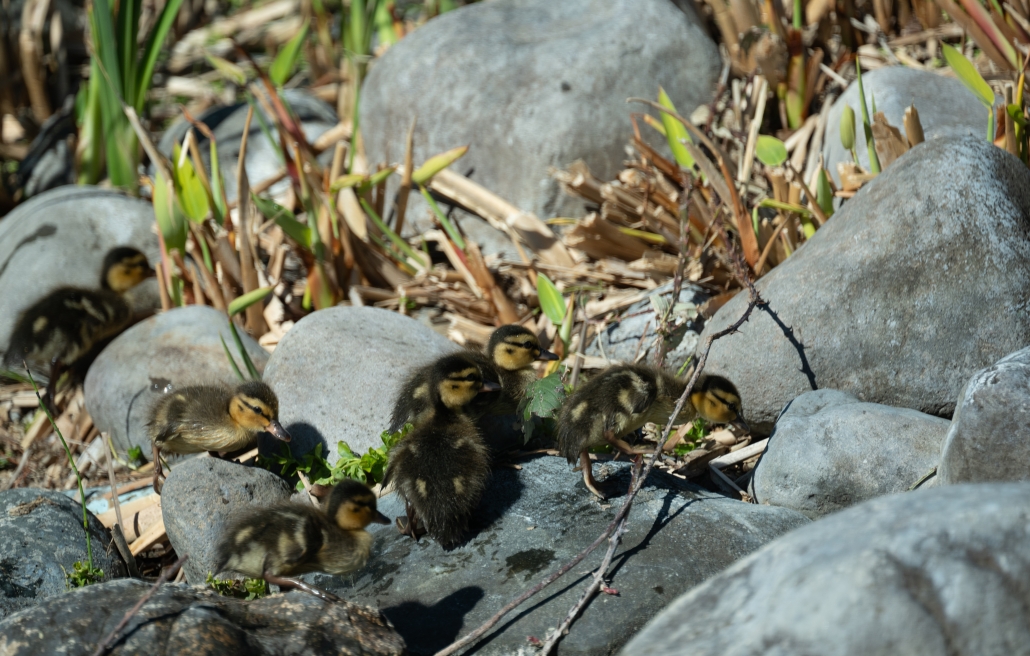
Keep going.

Tough Going.
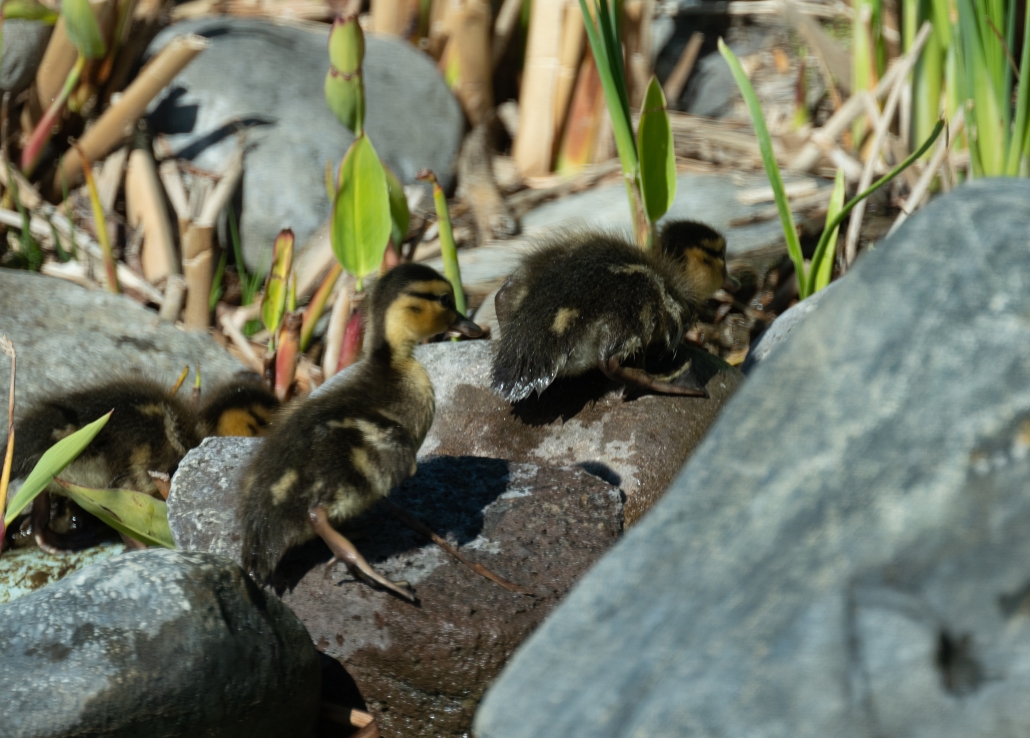
Rock climbing
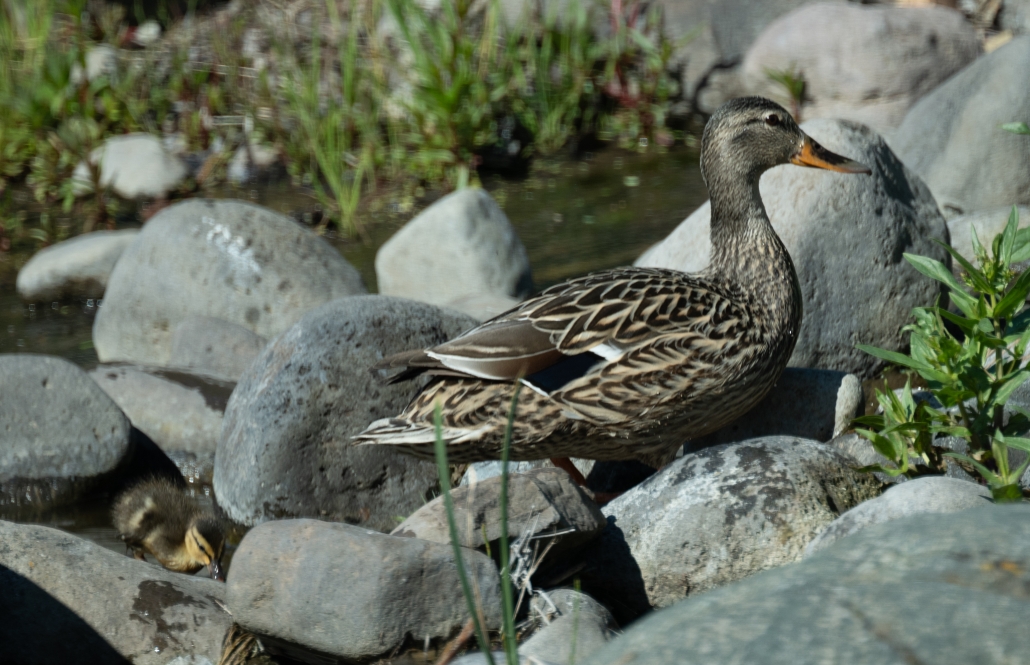
Where is everyone?

Out of the forest

They went this way.
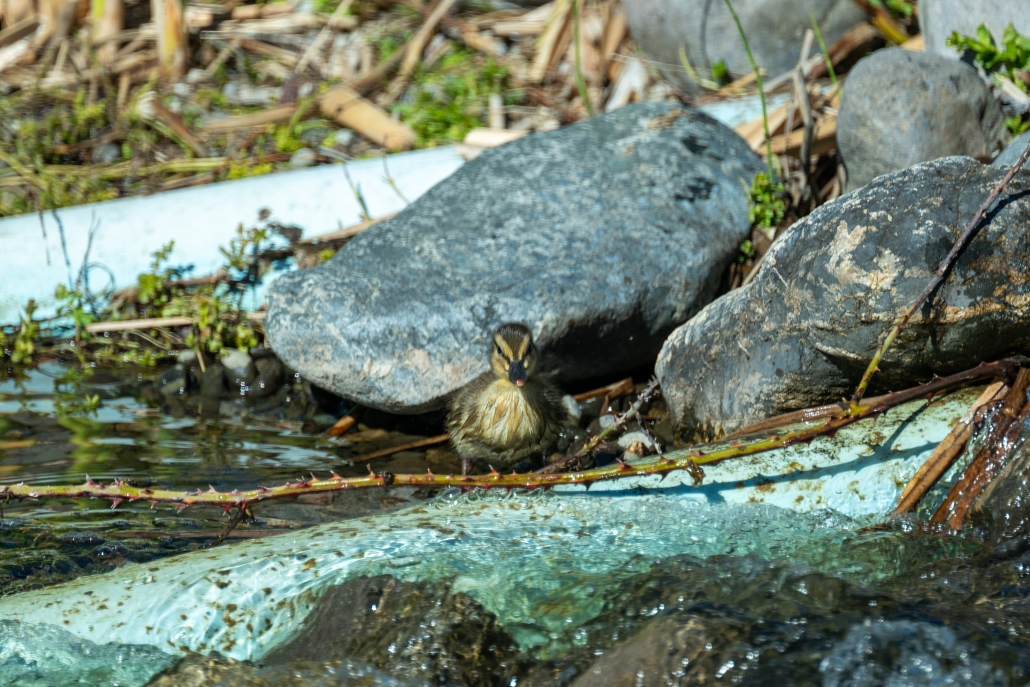
Now what?

In the shallows.

Swimming against a strong current.

The boulders
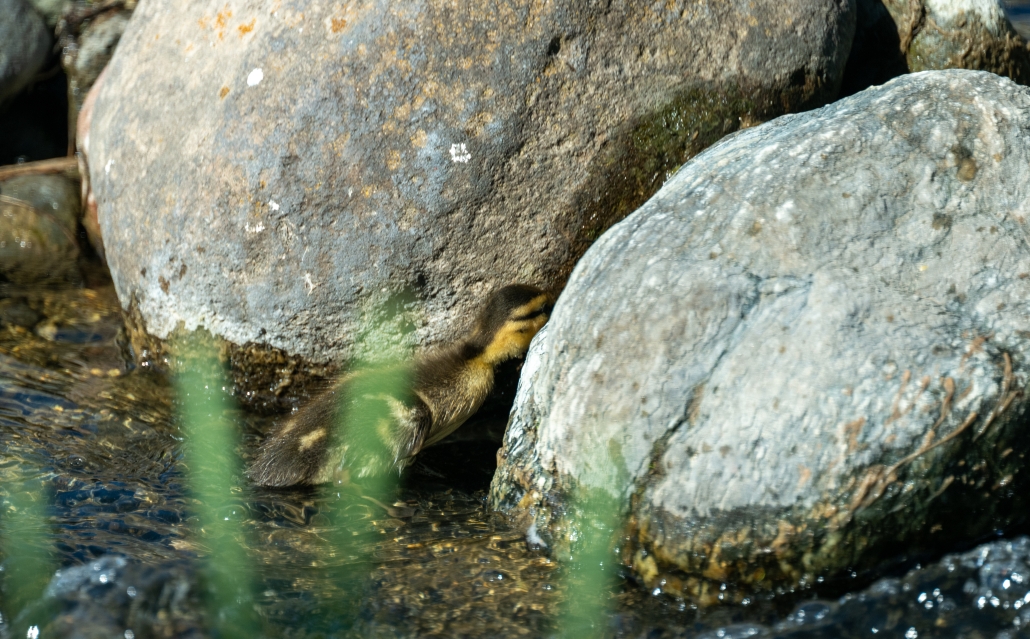
Can I get through here?

I found something to eat!
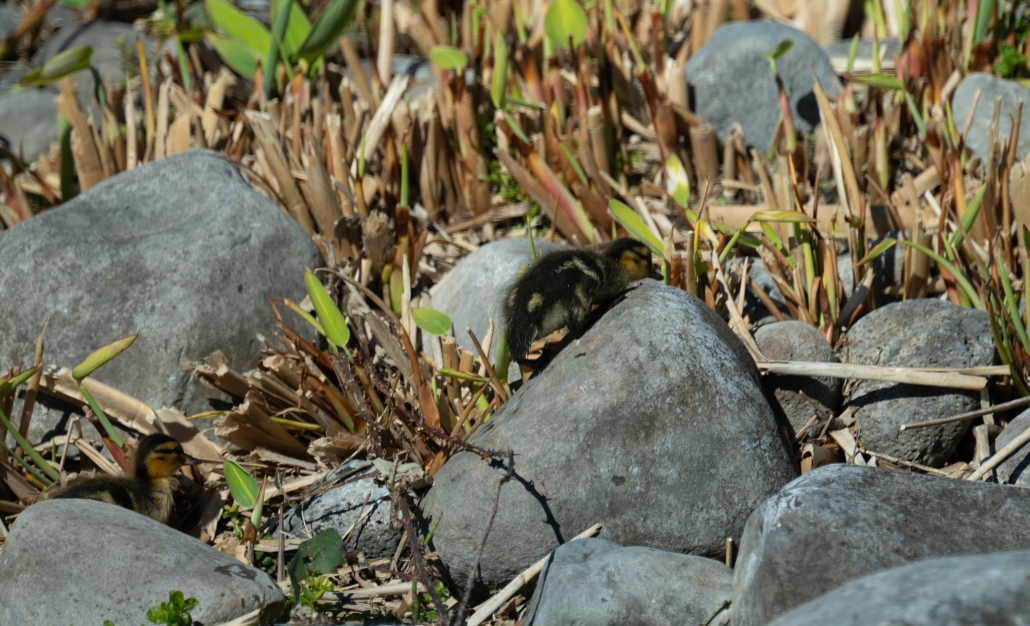
This is too much!

Back to open water

Looking for company.

Dad and uncle weren’t far away.

What a great day!
by Anne Newins
In a blatant imitation of bookstores’ sales tactics, I naively requested a handful of library volunteers to suggest some of their favorite books for the May display, anticipating five or ten suggestions per person. Instead they sent scores of titles. Trying to select a few representative samples, as is my wont, was impossible. Be assured that the display will be eclectic, including a host of genres. You will find history-true and fiction, mysteries, quirky stories, best sellers, old books, new books, and on and on. We hope that you also will consider some books that are under appreciated and deserve a wider audience. Enjoy!
Pictured: Liz Caldwell, dedicated library volunteer and avid reader.
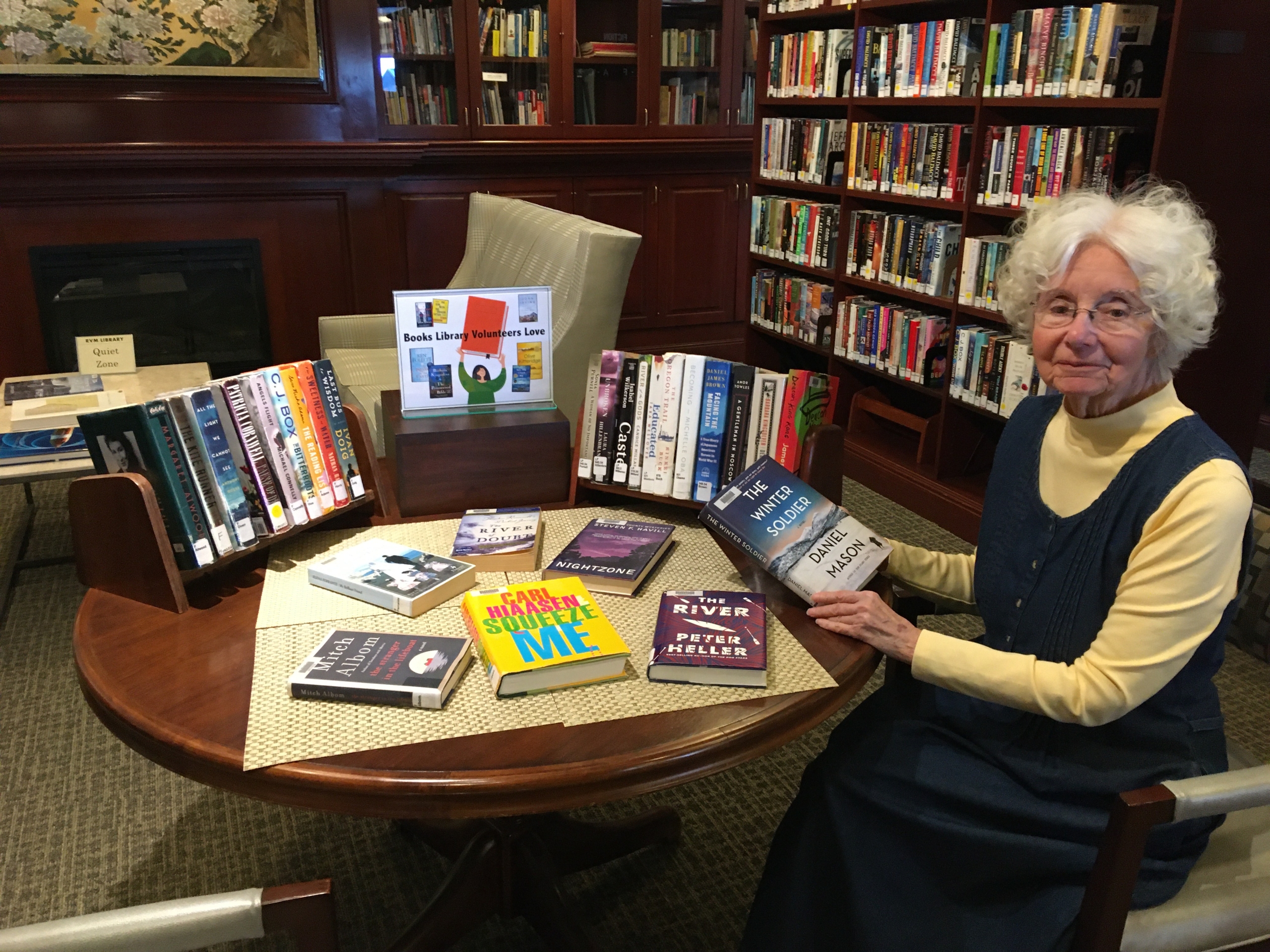
by Eleanor Lippman
Barbara was my friend during our elementary and high school days. Her parents owned one of the many small mom and pop businesses along Wyoming Avenue; their family like the others lived in the two-story houses behind and part of their stores.
Barbara was my favorite friend but her father’s store was NOT my favorite store on Wyoming Avenue.
B. Bogaslovsky’s bakery was the best of all of them. I loved walking past the bakery and inhaling the delightful smells coming from what was currently in their ovens.
Along the back of her father’s fish store were huge cement tubs – tubs larger than the laundry washing tubs in the basement of my parent’s house. Her father was a fishmonger and fish, still alive, filled those tubs, fish that were sometimes so large they could hardly turn around, so they remained listlessly in place, miserably attempting to swim. The front of the store held a few bins of fresh and often wilted produce. The store always smelled like fish and sometimes when we walked in, we would see the remains of a fish on the large cutting board, cut open and gutted, fishy eyes watching us. Her father used massive and dangerous looking knives to do the work. Going from the store to the family residence in the back was always frightening to a little girl like me.
In contrast, the kitchen behind the store where the fish found new homes was the hub of Barbara’s family life. Once there, it was easy to forget about the fish, the sorry looking produce and the butchering knives on the other side of the door. The kitchen was always bright, warm and smelled of good things cooking. Barbara’s two older brothers passed in and out and sometimes stayed to talk to us as if we were real people and not kids.
Our group of close-knit friends like to stop and visit that warm and inviting place on our walk home after elementary school because we knew that freshly baked cookies were often waiting for us. Barbara’s mother quickly found out which of her cookies I preferred and, I think, after a while, made sure there was a plentiful supply. How did she know? Once, as we tumbled through the doorway from the store to the kitchen, Barbara’s mother was removing a tray of cookies from the oven. She was visibly upset because she had been waiting on a customer and the cookies baked longer than she intended. On one side of the baking sheet the cookies were too brown and some were slightly burned. She coaxed the cookies off the sheet onto a cooling rack and when they cooled, she separated the burnt ones to discard. I told her I liked the dark and overly browned ones better and she gave the plate of them to me. We had a special bond after that because I found those over baked ones tastier than the others. I could always find a few waiting for me.
Barbara’s family, like so many families in our neighborhood, struggled to make ends meet. We were all accustomed to wearing hand-me-down clothing, darned socks and patched underwear, and clothes that we either had to grow into or were sometimes too small. Sometimes the girls even had to wear their brother’s hand-me-down white dress shirts as blouses and the argyle socks meant to be stylish with boy’s knickers.
Funny how boys never had to wear clothing meant for girls.
Shortly before we transitioned from eighth grade at Clara Barton Elementary School to ninth grade at Olney High School, we knew stopping at the fish store after school would be a thing of the past, as the high school was in a different location. And, Barbara told us her family planned to move. Usually that meant relocating to Oxford Circle, a post WW II new housing development further northeast than our old established Philadelphia neighborhood. Moving to Oxford Circle meant Barbara would have to transfer to a different high school. Happily, we learned her family would be moving to a row home just a few blocks away and Barbara would not be cut out of our lives.
The fish store closed for good. Barbara showed up every day at school wearing new store-bought clothes. Finally, she told us the family had settled into their new home and she invited a few of us to visit after school.
The brick row houses in Feltonville, as our northeast community was called, were constructed shortly before and after the depression in 1929. A particular construction pattern occurred; the houses facing the wider streets were large, those built along the narrow streets were smaller because each house was narrower. From the front, all of the homes in the neighborhood looked pretty much the same. Some houses were constructed along streets so narrow they were effectively one-way meaning when vehicles were parked on one side of the street, motorists had to drive carefully to avoid hitting the curb on their left or the parked cars on the right — those houses very, very small inside.
A half a dozen or so of Barbara’s friends and I followed her home from school that day. We approached her front door expecting to see the familiar faded and threadbare furniture and worn wooden kitchen table and chairs from their old house. After all, the fish store on Wyoming Avenue was hardly the most prosperous store in the area.
We were speechless when she opened the door. The house was huge. Thick, soft beige wall-to-wall carpet, something we had only seen in movies, flowed from the entry to the living room and dining room and onto the stairs leading to the second floor. Everything was new. The house was decorated in soft muted blond colors, our footsteps made no sound. Each window had drapery in addition to the familiar Venetian blinds that covered the windows in our houses.
No aroma of freshly baked cookies.
Barbara knew she had stunned and surprised us. She invited us to go upstairs to her bedroom.
By this time, we all felt as if we had been transported into a palace. None of us had ever seen a house so new and so lovely. Plush wall to wall carpets were things people dreamed about. Nothing from their old house was there. Even the smell was new and fresh.
Barbara’s bedroom was decorated like the rest of the house. A blond nightstand separated her two twin beds and, in addition, each bed had a nightstand on their far side. Three nightstands in one room! The lamps by each bed were cut glass, delicate and feminine. We flopped on the beds and looked around. Soon we removed our shoes to better appreciate the thick carpet. Her bedroom was probably larger than my parent’s large bedroom in my own house. At first, no one could believe what we saw and we were strangely silent. We knew Barbara was enjoying this. Soon we were flooding her with questions and she laughed and refused to answer most of them. After we became bored with her keeping quiet and refusing to speak, so we slipped into the usual teen-aged girl after school topics, chattering away as we had in the past. We forgot the brand-new quilted bedspreads, the tasteful pictures on the walls, the newness and freshness of everything.
Sandy picked up an eight by ten framed photograph of a young woman that faced Barbara’s bed.
“Your mother was very beautiful when she was young,” Sandy said.
Without stopping to think, Barbara replied, “That isn’t my mother.”
She briefly furrowed her eyebrows and a strained look came into her eyes. She had said something she had not planned on saying.
The photograph traveled from girl to girl and each one of us admired the beautiful dark haired, dark eyed lady and we all agreed she looked just like a younger version of Barbara’s mother.
Barbara did not say anything for a while. She took the photograph, stared at the face, and returned it to the nightstand.
“This is my mother’s sister.”
She looked at each of us directly into our eyes and asked if we could keep a secret. Of course, we all nodded yes.
“After my mother’s sister died, my mother inherited her estate. I never met my aunt. She lived in Alaska.”
What a story, we all agreed.
Quietly, Barbara said, “My mother’s sister worked as a prostitute along the Alaskan frontier. Don’t you ever dare to tell anyone.”
We were speechless.
I kept Barbara’s secret for nearly fifty years until I visited Alaska in the summer of 2000. I traveled to Anchorage, the starting point for a bicycle tour around the state. While in Valdez, I visited a local museum and as I was searching through the books about Alaskan history and Alaskan oddities, my eyes fell on a book about Alaska’s frontier prostitutes. I remembered Barbara’s aunt when I picked up the book. Inside, along with the text, were dozens of photographs, some faded and some blurry.
I looked at each one, but never found the photograph for which I was searching.
Barbara’s secret was secure.
Until now.
The Wager: A Tale of Shipwreck Mutiny, and Murder, David Grann, Random House, 2023.
 This book was recommended to me at the lunch table one day.
This book was recommended to me at the lunch table one day.
The Wager is an English ship which sails in 1740 from England with an armada of other ships in search of a prize to be taken from the Spanish. The story begins as the reader is introduced to 3 characters who will play pivotal roles. The lieutenant, who becomes captain of the Wager; the 16 year old gentleman volunteer, who becomes a midshipman; and the gunner, who leads a group to safety.
While rounding the Horn the armada gets separated and the Wager is cast upon some rocks. Was it incompetence? The crew that survived struggle ashore on a rocky mountainous island. While raiding the shipwreck for supplies and arms, the castaways struggle to find food and shelter. As hunger grows, so does the dissatisfaction. One group wants to return through Drakes Passage and up the Brazilian coast to safety. Another group wants to continue up the coast of Chile to confront the Spanish as their orders urge. When the two groups disagree, is it mutiny?
The Wager takes its place beside other books of shipwrecks and castaways, such as Endurance about Shackleton; Skeletons on the Zahara – off the west coast of Africa; and The Terror – the Northwest Passage. It is fully annotated with extensive notes, a bibliography and an index.
David Grann is also the author of Killers of the Flower Moon. The Wager is non-fiction that reads like fiction. A rousing adventure even if the person who recommended it doesn’t remember doing so.
This book is available from the RVM library in regular and large print.
submitted by Mary Jane Morrison
Events listed in italics are tentative
Links connect to performer bios and/or programs
Programming subject to change. Programs will NOT be broadcast on Channel 900.
Manor Express available until 8:30 p.m. Thursdays
Thursday 05/09 YSSO Orchstra
Thursday 05/16 Trio La Forza: piano, clarinet, bassoon
Thursday 05/23 Joyful Voices
Thursday 05/30 The Grapefruits: piano, horn
Thursday 06/06 Miss Diana’s Children’s Ballet
Thursday 06/13 Siskiyou Violins
Thursday 06/20 Kirby Shaw Singers
Thursday 06/27 Chihuahua Desert Western
Thursday 07/04 Patriotic Sing-along with Rita Reitz
Volunteering in the library is full of surprises. Recently, we were startled to find that we have over 100 books that are related to espionage, more than expected. These include both fiction and non-fiction books. What has made this topic so popular in America?
Readers have been interested in spy stories for centuries. In 1821, James Fenimore Cooper wrote The Spy, followed by The Bravo in 1831. World Wars I and II triggered more spy novels, but the genre really took off during the Cold War. According to a column in novelsuspects.com, “With so much anxiety and speculation surrounding the tense relationships between these world powers, spy novels became a way for writers to take a guess what was going on behind the scenes.” Since 9/11, many recent novels are accounts of spy organizations fighting terrorist threats.
Spy novels typically include characteristics of adventure and detective novels, including a strong hero/antihero. The main character usually is a spy trying to function in a political environment. Many of the books are complex and the ending may not always be happy. On the other hand, Richard Osman’s Thursday Murder Club stories feature a cast of retired spies and are amusing.
Daniel Silva, Ken Follett, Robert Ludlum, and Alan Furst are popular with Manor residents, along with many others. I would like to highlight a few favorite books:
Anything written by John le Carré. The late le Carré is considered one of the best novelists of the post cold-war era. Described by Dwight Garner as a “sophisticated, morally ambiguous writer,” even readers who are not fans of spy fiction might enjoy his books. Le Carré was a member of the British Foreign Service and his understanding of how these agencies work underlies many of his books.
A Woman of No Importance: the untold story of the American Spy who helped win World War II, by Sonya Purnell. This 2019 best seller tells the true story of Virginia Hall, a socialite who was the first Allied woman deployed behind enemy lines and was a major force in the development of the French Resistance. In one of her death-defying experiences, Hall hiked over the Pyrenees, despite having a prosthetic leg.
The Secret Hours, by Mick Herron. Herron fans may already have read his Slough House series and been watching Slow Horses, a television series. The RVM library recently ordered a stand-alone novel, The Secret Hours, which should be available to residents in the latter half of February. Few could resist a book with the opening line of “The worst smell in the world is a dead badger.” This witty, suspenseful, and complex book is full of interesting British spies, and was described by reviewer Chris Hewitt as “the good guys are bad, the bad guys are worse, and the reader is in luck.”
Readers interested in doing a little snooping themselves might investigate the Red Dot and Black X shelves located opposite of the main library entrance. These donated paperbacks are not catalogued and may be borrowed for as long as you desire.
This month’s photo exposes a suspicious character engaged in literary espionage. Uh-oh!

We all know that the prefixes -in, -im, -ir, -un, and of course -non, usually mean not, as in incomplete (not complete), impossible (not possible), irregular (not regular), unhappy (not happy), and nonsense (doesn’t make sense).
But we don’t seem to have positive versions for some of these negative words. If disheveled means messy, shouldn’t the opposite be heveled? And shouldn’t the opposite of disgruntled be gruntled? And the opposite of unhinged be hinged?
Clearly inert means incapable of movement or activity, a negative attribute. So shouldn’t ert mean active? And if immaculate means “unblemished, clean,” shouldn’t maculate mean “stained, blemished”?
Here’s a little poem written by someone named Bindy:
I’m a virgin, at least for now, still,
And yeah, I am over the hill.
But after this date
I will be maculate;
(At least it’s my hope that I will!).
-Bindy Bitterman, Chicago, Illinois
Sometimes the very same prefixes that usually mean the negative mean the positive, such as intelligent, and ingenuity, and innocent. And imply, impetuous, iridescent, and irrigate. If we remove the prefix, is the remaining word the negative? Should the negative of intelligent be telligent? And if ingenuity means clever, does genuity mean NOT clever? And what about innocent (uncorrupted, sinless), clearly a positive quality? Shouldn’t nocent mean criminal? If something is not important, is it portent?
There are lots more in this category: irritate, impetus, impinge, implicit, implode, impose.
To make matters even more confusing, there are some words that mean almost the same with the negative prefix as without: implant/plant; inflammable/flammable.
Then of course there’s disinterested, which doesn’t mean “not interested” at all, but rather “without bias.”
Here’s something to ponder: If an orchestra is meeting for the first time, do they hearse rather than rehearse?
Aren’t you glad you grew up speaking English? And if you didn’t, how did you ever learn this inconsistent (NOT consistent) language?
I leave you with another poem (you’ll need to add prefixes to the words you don’t recognize):
I know a little man both ept and ert.
An intro-? extro-? No, he’s just a vert.
Sheveled and couth and kempt, pecunious, ane,
His image trudes upon the ceptive brain.
When life turns sipid and the mind is traught,
The spirit soars as I would sist it ought.
Chalantly then, like any gainly goof,
My digent self is sertive, choate, loof.
— David McCord; The Oxford Book of American Light Verse; 1979.
Reader beware! The author has no formal credentials in the fields of psychology, physiology, or life management, but decades of personal experience with confusion, indecisiveness, procrastination and wide-ranging dysfunction have convinced him that he is qualified to experiment and advise on those subjects. Use at your own risk!
Do you ever feel like your brain consists of a multitude of gerbils, all running at top speed on their exercise wheels with no net progress whatsoever? I do, and after protracted research and reflection I have come to understand why, and what to do about it. And I am going to share that with you.

calm but alert gerbil
The secret: If it acts like a gerbil, treat it like a gerbil! Unfortunately, the rodent model of human cognition has received far too little popular attention. Herewith, a brief description to facilitate effective interactions.
First, forget about the scientific jargon involving neurons, synapses, etc. Your nervous system is a nation of teeny tiny gerbils, organized into interconnected communities according to their occupational specialties. When the system is well-supported and operating smoothly, it produces a high GEP (Gerbil Economic Product) for export to you.
There are Collector Gerbils who receive and import resources from the Outside (e.g, sounds, sights, smells, etc.) and transform them into what we can think of as kibble. A wide range of kibble of different shapes, sizes, colors, tastes, and digestibility. These they pass on to the Sorter Gerbils.
Sorters have limited autonomy; they can pass certain kinds of kibble directly to the appropriate specialists, but mostly they are guided by the decisions of a committee of Silverback Gerbils, who oversee the distribution of inputs in order to maintain the GEP.

Team Gerbil, ready for project
Usually things work smoothly, but sometimes the input causes the Collectors to produce an imbalance of kibble types, including too much poorly digestible kibble that takes a long time to process. Then the Sorters are passing too many bits to the Emergency Response Gerbils, and becoming frustrated by the overload and unbalanced inventory.
The Silverbacks, faced with multiple unaccustomed problems, fall to arguing among themselves and fail to instruct the sorters. As a result, the communities receive a downpour of poorly sorted kibble that overwhelms their infrastructure and does not provide the necessary resources. The communities of Producer Gerbils fragment within, and try to raid other communities for the necessary resources. Order breaks down, and GAF (Gerbil Adrenaline Flow) spikes – sometimes dangerously. This condition is known as Non-Selective Overload (NSO).
What then? Every gerbil has access to an exercise wheel, individual or communal. Under normal conditions an appropriate amount

Stressed gerbil working out
of well-timed exercise keeps the individual and community functioning. When overload builds up, the gerbils instinctively try to burn up their GAF by exercising harder and longer on the wheel, sometimes skipping work to do so. Productivity goes down.
When full-blown NSO is occurring, the gerbils become almost demonically hyperactive; they leap on their wheels and dash frenziedly “forward” in a glazed-eye, mouth-foaming sprint. Both gerbils and wheels squeak and chatter loudly, and of course GEP plummets. You can’t help but notice this – often acutely.

Ultimate Overload
Dealing with NSO – the solution to the problem of getting your gerbils back to work is, somewhat counterintuitively, a different kind of overload. Ultra-Selective Overload (USO) is a technique for replacing the distractingly diverse and unbalanced input of NSO with a surfeit of a very few kinds of attractive and enjoyable input. The gerbils are made happy by what they get, realize that production is impossible, and subside into mellow passivity. GEP remains very low, but it is essential to recognize this as a necessary period of recovery that will result in a quicker return to normal behavior.
Providing Ultra-Selective Overload: Control of the material that the Collector Gerbils can access is one of the most effective means of getting to USO. One possibility is total shutdown – essentially, starving the communities into submission. Unfortunately, the starting point almost always involves large existing stocks of poorly digestible kibble that keep the communities operating poorly and unhappily.

Recovering gerbil
So — and here comes the advice – we need to pick out a few Collectors and feed them input that will produce lots of kibble with pleasantly hypnotic qualities. It has to be sustainable; the gerbils do not calm down and get off their wheels immediately — they need to be coaxed into resting mode over time. Taste, smell and touch are hard to sustain; sight and sound are the obvious choices for kibble raw material in our era of technologically augmented input.
HOW TO: Let’s acknowledge that natural may be best – although peripheral inputs may distract, real-world floating clouds, fluttering leaves, and flowing water can do the job. But that means you have to find a desirable environment where you can hang out any time, and more or less indefinitely. Realistically, you may need to soothe your gerbils at night, or in bad weather, or in the middle of a city. Then —

Completely soothed gerbils
We use our smart TV, computer, or maybe cell phone (but screen and speakers are pretty small). Some of the things that my gerbils respond to can be seen or downloaded by clicking on https://thecomplement.info/wp-content/uploads/2023/06/Soothing-methods.pdf. Yours may be different, but there are many sources offering various alternatives. For simplicity, my examples are accessible on Youtube, which can be accessed free from any computer/phone browser with an internet connection, and from most if not all smart TVs.
So check them out. Get a feeling for what might work before the furry little rascals slide all the way into anarchy. Once you have taken the initial steps into gerbil control, you will find that you are better positioned to start adjusting the community diet as soon as the first few wheels start squeaking. Remember, if you look after your Inner Gerbils, they will look after you.